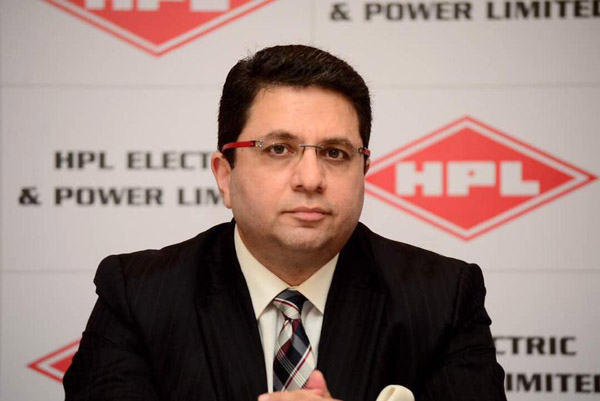HPL, one of India’s leading electrical equipment manufacturing companies, which manufactures a diverse portfolio of electric equipment, including, metering solutions, switchgear, lighting equipment, and wires and cables, catering to consumer and institutional customers in the electrical equipment industry. Mr Gautam Seth, Joint Managing Director – HPL Electric & Power Ltd. shares his insights on company’s smart meter market overview and its growth.

Recently HPL has secured Rs 179 cr worth smart meter order which is a huge boost especially post covid, please tell us how the performance has been this year despite the Pandemic.
We truly believe that HPL offers a wide range of best-in-class metering solutions. HPL Power & Electric recently, has received a Rs 178.9 crore contract from the largest private utility in a state in eastern India, demonstrating their proficiency in the smart metering technology industry. This is the beginning of a positive cycle for smart metre technology adoption, which will lead to increase demand from electricity utilities.
Also we would like to share an insight with you that we have received a large number of contracts. We have bagged Rs 372 crore order for switchgear, cables, and other relevant accessories for low-cost housing projects in Andhra Pradesh. Following the first lockdown, sales has increased, and the company has anticipated a stronger growth.
HPL announced its financial results where the revenue has grown 23% YoY to ₹280 Crores in Q2 FY22. How do you view this result and do you expect smart meters to continue to play a dominant role in your company’s business?
Company’s revenue has grown 23% YoY to Rs280 crores in Q2 FY22. Its metering and consumer segments has grown by 22% YoY and 20% YoY respectively to Q2 FY22.
We surely believe that Smart meters play a vital role for HPL, the new metres are compatible with both 4G and 5G networks, providing a dedicated channel for smart metering and avoiding any failures due to interference or obstruction caused by congestion or blockage on the public network.
There had been reports of power theft or losses, how do you think technological innovations like smart meters or any other innovations in your product line going to curtail the issue?
As per researches, although the electricity theft has decreased by 50%, but there are still pockets where it is a matter of concern. Hence, India loses billions of rupees due to unbilled and illegal electricity consumption.
As per the technical experts, we believe, smart metres are becoming extremely important in emerging countries like India. Main purpose of smart meters is to remove theft, reduce distribution losses and pilferage of power. It is used to measure electricity, turn off the customer’s power supply remotely, or turn off particular appliances in response to increase demand. Our smart meters can optimise energy efficiency and load balancing by remotely controlling electricity consumption. Whereas our R&D team is working in manufacturing the similar range of products.
Smart metering is your predominant line of business. Do you see your market leadership in smart meters positively influencing your other verticals like switchgear, lighting, wires & cables, etc?
Yes, smart meter is the most powerful component of our business. This has further strengthened our business. We are the front runners in Smart Metering field proving state-owned and private utilities with latest technology. Along with this we have other verticals including metering solutions, switchgear, lighting, wires & cables, catering to customers and intuitional customers.
Digitalization of electric distribution is also improving and providing flexibility across the entire power value chain. Digital switchgear helps to improve operational efficiency by reducing switchgear footprint in power rooms and utilising energy efficiently for switch gear.
HPL Electric has rolled out Narrow Band IoT-based smart meters. Tell us more how NB-IoT communications will reduce interference in performance & any obstruction on public networks?
NB-IoT is a new 4G and 5G technology that provides a dedicated channel for smart metering, preventing any performance degradation caused by interference or obstruction on the public network. With this technology, data would flow smoothly through a dedicated channel and difficulties caused by public network congestion will no longer affect the smart metre operation. It will also make it feasible to take a larger number of remote metre readings therefore ensuring consumer safety.
This unique technology which will take Indian Smart Metering industry to the next level. We have a diverse line of electrical equipment to meet the various need of market. Our manufacturing facilities are state-of-the-art, allowing us to expand production to meet the country’s current and future needs. We also have a strong R&D foundation, with an objective to create technological advancements in electrical equipment solutions for a variety of applications and needs.
India is planning a pan-India rollout of prepaid energy meters, estimated at some 250 million, over the next 3-5 years. How is HPL gearing up and how do you see prospects for HPL?
As per the reports, India’s smart metre programme aims to replace 250 million old metres with smart metres in order to help debt-ridden electricity supply companies to increase annual income in coming next 3-5 years.
We as HPL Electric group are committed in improving its smart metre technological base and positioning ourselves as a market leader in the smart metre area. HPL’s manufacturing capabilities are backed up by a large sales and distribution network with pan- India presence. Single phase, three phase, and LTCT/HT energy metres, smart metres, panel metres, prepayment metres, net metering solutions, and transformer metering solutions are all part of the company’s metre range. We want to expand our product smart metre offering in domestic market share In the medium and long term, the company sees a huge growth in the smart metering market. HPL Electric has a production capability of around 9 million energy metres per year. This capacity is spread over a variety of metre, mostly conventional and smart metres. Currently the company’s capacity in utilisation of energy metre is 70-75%, which is sufficient to meet the increasing demands.









